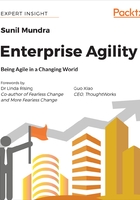
Goal of the book
My goal through this book is to highlight that the approach to enterprise agility must be based on treating the enterprise like a living system, say a human body, rather than treating it like a machine, such as a car. When a machine slows down or breaks, the relevant part of the machine can be fi xed or even replaced. However, if the overall health of a human being is not good, it can rarely be cured by just fi xing a specific part or parts of the body.
This book is about improving the enterprise's health and is not just about fixing something which is broken and localized, say a fractured leg. The key message that I wish to convey is that enterprise agility is not about making the parts Agile and then adding it up—working on each part separately. The human body analogy will be to improve agility in hands, legs, head, eyes, and so on, to hope that the overall health will improve. It may also involve diet, exercise, and stress management, which result in the holistic wellbeing of a person.
Optimal functioning of human organs does not imply overall good health, but at the same time good health needs all organs to function well. Similarly, to achieve optimal agility at the enterprise level, the components of the enterprise—people, processes, structure, governance, technology, and customers (yes, I consider the customer to be an integral component of the enterprise!)—must be enabled and leveraged for greater agility. Hence, in the book I have approached enterprise agility from both holistic and component level perspectives.
Moreover, just like the meaning of good health is specific to an individual, what "good" agility is will be specific to the enterprise. Hence, enterprises must create an action plan to enhance and sustain agility based on their respective context. As in case of health, there are patterns that are known to inhibit and enhance agility. I have shared some patterns in the book, which enterprises can use as pointers for creating the action plan.
I am also passionate about sharing my knowledge, and this, along with my conviction about and belief in the power of agility are the key drivers for me to write this book. Being in ThoughtWorks, which has groomed and nurtured many well-known thought leaders, I harbored self-doubts about being an author and thereby potentially being compared with these great thought leaders.
However, my ex-colleague and now a good friend Matthew Stratford put things in perspective. He said, "Not every guitarist can be Jimmy Hendrix, but they can still make music which at least some people will like." I have drawn inspiration from this statement throughout this tough but highly fulfilling journey.